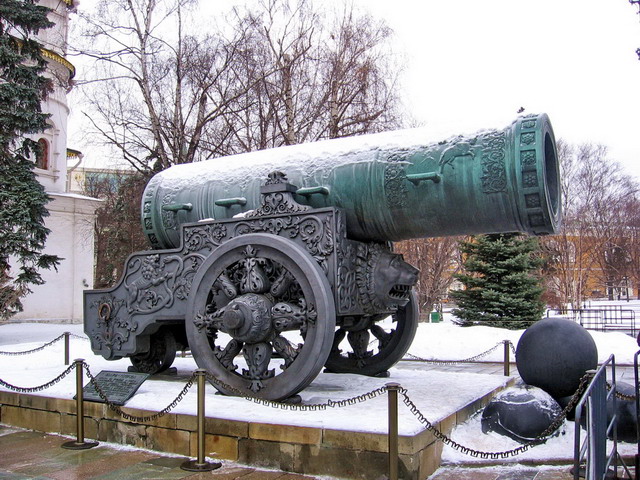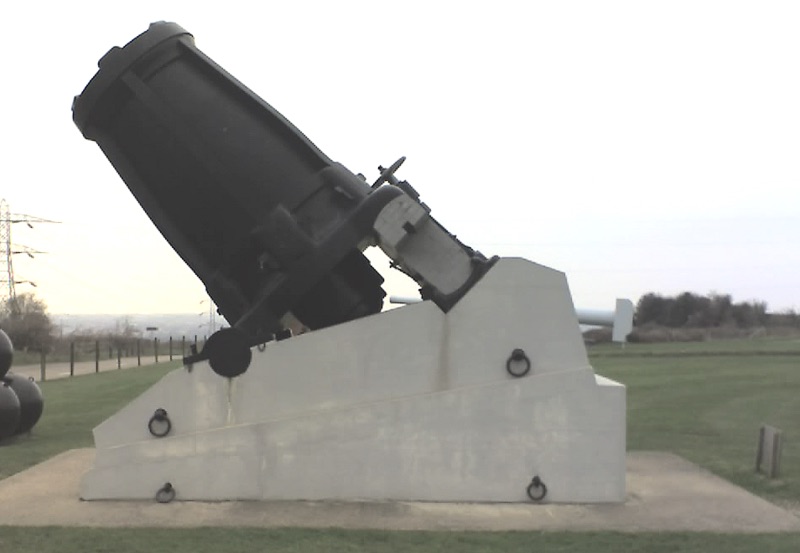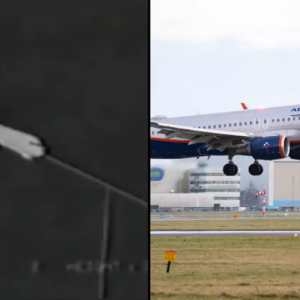Schwerer Gustav or Hitler’s giant gun was a fearsome weapon of war.
A distinctive feature of artillery of the Second World War were cannons of every increasing size and caliber. One other such weapon was the 914 mm Little David, constructed for the American army. It was intended to be used for attacking Japanese bunkers at the end of WWII. This mortar was the biggest in the world, but it was also never used in combat. The Japanese surrendered before its deployment.
Schwerer Gustav was conceived prior to the beginning of WWII when Hitler demanded its construction as a precursor to the invasion of France. It was to aid the German Army in penetrating the Maginot Line. Its construction missed the invasion of France but it did take part in some actions throughout the war. After years of development and construction, the weapon’s impact on the war was very small in the greater scheme of things. As impressive as the weapon was its fate was far from honorable.
In the following article, we will explore its precursors, conception and birth, lackluster history and ultimate fate during it’s brief, yet explosive life.
Grandfathers of the Schwerer Gustav
Enormous siege guns are nothing new to war. They have been employed in some form or other since the late middle ages. A great example would be the impressive 890mm Tsar Cannon employed by the Russians around 1586. This weapon weighs in at 39 tonnes and could fire rounds of 771 kgs. It is made of bronze and is actually a piece of art. The sheer size of the weapon itself, not to mention its ammunition rendered it somewhat useless in actual battle. It is suggested that the weapon was actually crafted more as a prestige piece than a weapon of war. This gun is currently on display outside the Kremlin along with some ornamental cannon balls.

Tsar Cannon [Image Source: Wikimedia Commons]
The Tsar cannon was not the largest caliber weapon pre 20th century, however. The British built a huge 42-tonne gun that could fire 914 mm exploding shells over 4km. This amazing weapon was called the “Mallet Mortar” and each projectile weighed in at around 1.25 tonnes. The Brits produced only two of these weapons and they were never fired in action. They were test fired of course but never used in anger.
Usage of these canons in the 20th century began with the Big Bertha (also known as the “Fat Bertha”) during World War I. Big Bertha proved its effectiveness against older fortifications by destroying several Belgian and French forts. However, these cannons were almost useless against newer constructions built of concrete reinforced with steel. This led to decreased usage of the 420 mm Big Bertha howitzers.
Mallet’s Mortar [Image Source: Wikimedia Commons]
Stay on target
The German military industry wasn’t discouraged and new grand cannons were developed despite the Big Bertha’s failure. Karl-Gerät, also called Thor (like the Viking thunder god) and Mörser Karl, were developed between 1937 and 1940. These were self-propelled siege cannons that utilized 600 mm wide barrels. They fired projectiles weighing between 1250 and 2170 kilograms. These big guns had relatively short firing ranges of “just” 10 km with the lightest shell, but it was used with varying success between 1941 and 1945.
Railway guns
Although this impressive weapon is termed a railway gun its sheer size severely restricted its movement between deployment. The gun was actually transported in sections and assembled on site. This prevented the piece from being transported assembled. The gun could be broken down into five units. These were the breech ring and block, the barrel in two pieces, the barrel jacket and cradle and trunnions. The rest of the mounting was split lengthwise for movement between battle sites. All components were transported on special flat wagons except for the bogies that could be transported on their own wheels.
True railway guns were a large artillery piece mounted on a specially designed railway wagons. The Krupp group built many such pieces for the German War effort during both world wars and smaller pieces often formed components of armored trains. In general, there is little if no need to dismantle the weapon which can be transported in whole between combat zones.
They are also not a 20th Century invention. The very first gun used in anger was utilized during the American civil war. They involved the use of a banded 32-pounder Brooke Naval Rifle mounted on a flat car and shielded with a sloping casemate. Such weapons were used during the Battle of Savage’s station. Railroad guns also had applications in the French and British Armies during the 19th century.

American civil war railroad gun [Image Source: Wikimedia Commons]
Back to Schwerer Gustav
All well and good but let’s get back to the largest cannon ever used in battle. Schwerer Gustav shell was 800 mm or 80 cm in diameter. This baby was a railway gun developed by the Krupp family company who also developed the Big Bertha cannons in WWI.
It was designed in the 1930’s in order to destroy the strongest defensive facilities of their time – the Maginot Line in France. This defensive line was built by the French along the frontier with Germany and consisted of different obstacles, concrete bunkers and fortifications, and weapons installations. The desired specification was that the cannons should be able to destroy 1-meter thick layers of steel or 7-meter thick walls of reinforced concrete. Fate changed its plans when the war began. The Wehrmacht invaded France by passing through Belgium, thus circumventing the Maginot Line and conquering France without the necessity of destroying the defensive line.
According to Wikipedia, Schwerer Gustav weighed in at around 1350 tonnes and was capable of firing 4.8 metric ton heavy projectiles at a distance of 47 km with a muzzle velocity of 820 m/s. Schwerer Gustav damage was incredible! Although not used to fulfill their initial purpose, the Gustav super cannons were transported to the Eastern front and participated in the Fall Barbarossa (Operation Barbarossa in German). During this operation, the cannon was used for the siege of Sevastopol. After that, it was transported near Leningrad (now Saint Petersburg) and started preparation for the siege, but the operation was canceled. The gun was sadly later destroyed in order to avoid its capture.
Birth of the Schwerer Gustav
This impressive weapon has its origins during 1935 as part of the Wehrmacht study which examined the kind of armaments needed to penetrate the newly completed defenses of France.
At the commencement of the Second World War, Hitler was eager to extend his power into western Europe. His ambitions included the annexation of France. Learning from lessons made during the Great War, the French had fortified their border with Germany. The Maginot Line was an impressive barrier of steel and concrete that for all intents and purposes should’ve been impenetrable. This defensive structure dominated French military thinking during the inter-war years. This thinking was its great strength and as it turned out its fatal flaw.
Unable to keep up with modern advancements in warfare, the Maginot line would later prove to be useless when the German launched their blitzkrieg assault on the French through Belgium. This tactic had been honed during the Spanish Civil War and proved devastatingly effective throughout the early stages of the war.
Forging the Schwerer Gustav
But we are getting ahead of ourselves. At the time, the breaching of the line was a possible strategy to adopt and as such Gustav Krupp was approached to provide ballistic data for such a hypothetical weapon. Gustav was a leading German steelworks and armaments manufacturer. This request was met partly as a propaganda stunt and partly as a design exercise. In 1936, Hitler himself visited the factory and again asked Gustav the same question in person.
Krupp was able to provide the Fuhrer with an extensive and accurate answer based on their earlier calculations and assured Hitler that although it would be difficult, it was a distinct possibility. It can be argued that he may have bought into the national socialist movement or was fully aware of non-compliance owing to the fate of Hugo Junker. In either case, Krupp took a gamble and set his design team to work on a concept model for the weapon.
In early 1937, Gustav was in a position to show his designs to Hitler. The project was approved and 10 million Marks were set aside for the project with one request. The gun must be ready by the spring of 1940 for the attack on the Maginot Line.
Missed deadlines aren’t always bad
The weapon’s construction proved even more difficult than first anticipated. The barrels forging was a particularly difficult endeavor. The stipulated deadline came and went without the gun being delivered. As fate would have it, its intended use was superfluous as the German war machine simply outflanked the defensive line of the French. Other than Hitler, German High Command didn’t really miss the lack of this super weapon.
Towards the end of 1940, the barrel was finally ready and was test fired in 1941. The gun’s carriage was also ready for deployment. The entire assembly was taken to the Rugernward range on the Baltic coast for complete assembly and test firing to be witnessed by Hitler himself. On completion, the weapon was given as a present to the German war effort by Gustav and it was named in his honor. Whether this “gift” was out the goodness of his heart or fear for his life will never be known.
Deploying the Schwerer Gustav
Gustav finally went to war during the siege of Sevastopol in July of 1942. The gun’s assembly took a total of three weeks using a workforce of 1,420 men. Fully assembled the weapon was 43 meters long, 7 meters wide with the axis of the barrel a mere 7.5 meters about the track. Bejesus!
The weapon actually required a special four-track section to be laid to put the gun in place. The inner tracks accommodated the bogies with the outer tracks needed for the gun’s actual assembly.
“Various parts of the mounting were then built up on top of the bogies; the barrel was assembled by inserting the rear half into the jacket and then fitting the front half on and locking everything together with a massive junction nut. The barrel was then fitted into the cradle and the whole assembly hoisted up and lowered onto the mounting. After this, the breech ring was fitted to the end of the barrel by another huge nut and the 20-ton breech block slid into place.” – WorldWar2DataBase
Schwerer Gustav firing range
After the labor of love that is the weapon’s assembly, the gun was ready for action. Gustav began its assault on the Soviet fortifications of Sevastopol, lobbing 4.7-tonne high explosive shells deep within the besieged city over a range of some 47 kilometers. The gun could also unleash 7-tonne concrete piercing shells over a range of 37 kilometers away. One such shell was reported as penetrating 100 feet into the earth before detonating in an underground ammunition store. During the siege, around fifty of their shells were unleashed on the city.
After the siege Gustav seems to have trundled out of the sight. It was intended to be used during the siege of Leningrad but the Russians repelled the Germans before the weapon could be prepared. The only other recorded use of Gustav was in 1944 when it fired 30 shells into Warsaw during its aborted uprising, but this might also not be true. Conflicting reports seem to indicate that the rebellion was crushed prior to deployment of the gun.
“After that Gustav vanished. Numerous reports of its discovery in pieces, it’s scrapping, its capture or abandonment have been suggested but none of them standup to very close examination; spare barrels and ammunition were found, but the gun itself was never seen again (Despite some reports that it was found wrecked on its special train by a US army unit in Bavaria at the end of the war). It seems likely that it was simply scrapped sometime during late 1944.” – WorldWar2DataBase
Feeding the gun
A gun of any kind is useless without something to fire. The Schwerer Gustav was no exception. She could accommodate two type of ammunition. High explosive and armor piercing. These shells were monsters in their own right.
The high explosive option had a weight of around 4.7 metric tonnes. They were unleashed with a muzzle velocity of 820 m/s and a maximum range of 48 km. These shells housed around 700kgs of explosive and on impact could create a crater 9.1 meters wide and 9.1 meters deep! Wow!
The armor piercing option was equally as devasting. They were around 3.6 meters long, weighed in at around 7.1 metric tonnes and were lobbed at a muzzle velocity of around 720 m/s. These shells, being heavier had a shorter range of around 38 km and explosive weight of 250 kg. They could penetrate 7 meters of reinforced concrete at maximum elevation. Their main body was made of chrome-nickel steel that was fitted with an aluminum alloy ballistic nose cone.

Dora shell [Image Source: Wikimedia Commons]
Schwerer Gustav and Dora, one or two guns?
Certain sources claim that two of these weapons were built, Gustav and its sister Dora. This may not be true. Some sources claim that German artillery crews had a different idea to the weapon. This was the less honorific nickname of “Dora”. It is for this reason that for many years it was believed there were two of these weapons when in fact they were the same piece.
Other sources seem to indicate that there were, in fact, two such weapons built and deployed by the Germans. These sources also indicate that Dora became operational in 1942 and was used in the siege of Stalingrad.
“Wreckages of two gun carriages were documented 80km apart, Dora at Grafenwöhr and Gustav north of Auerbach – by US and Soviet troops respectively.” – Quora
There are some images of captured pieces floating around with American troops posing on top of the barrel, they are compelling but seem to be of a smaller caliber. But they are clearly much smaller and lower caliber than Gustav mega guns, most likely K 12 guns. In either case, the weapons were destroyed by the Germans in March and April of 1945 to prevent their capture.
Interesting applications of the Schwerer Gustav
Germany also had plans of building something that would be described as a “self-propelled fortress”. The project was called Landkreuzer P. 1500 Monster and was to be powered by 4 submarine diesel engines. It was planned to be armed with a Schwerer Gustav as the main cannon with two smaller 150 mm howitzers in support. The armament would have also included several 15 mm machine guns for air defense.
The basic concept was for the main gun to be mounted on a self-propelled platform. This was most likely tank tracked legs supported the superstructure. The gun itself would be fixed, making the system technically a self-propelled gun platform rather than a super heavy tank or indeed a fortress.
If built, this beast of war would have totaled 42 meters in length, 18 meters wide and been 7 meters tall. It had a total weight of around 1,500 tonnes. The weapon was proposed on the 23rd June 1942 by the German Ministry of Armaments and realized, at least in concept by Krupp. The project was finally canceled in 1943.
The fate of the great gun(s)
Many conflicting reports and records exist about the late war fate of Hitler’s super guns. Most sources claim that on the 14th April 1945, this great weapon was destroyed before the arrival of the US troops. The Germans “figured” it was better to prevent the weapon’s capture than
Most sources claim that on the 14th April 1945, this great weapon was destroyed before the arrival of the US troops. The Germans “figured” it was better to prevent the weapon’s capture than allow it to be captured by the Allies. Its ruined “carcass” was found on the 22nd April 15 kilometers north of Auerbach and 50 kilometers southwest of Chemnitz. The weapon was apparently studied by Soviet engineers and transferred to Merseburg in the Autumn of the same year. No record of the weapon is known after this time.
Dora, if she existed, is said to have been transferred to Grafenwohr where it was destroyed in late April of 1945. American troops discovered the wreckage sometime after and the debris was scrapped during the 1950s.
Such an inglorious end to this superweapon.
Schwerer Gustav: The final word
The weapon had cost an eye-watering 10 million German marks with the ammunition costs lost to history. For that, the German war machine was rewarded with the demolition of a few Soviet and Polish defenses and one ammunition dump. This hardly seems a fair trade given the cost of the project, much like the Death Star in Star Wars. That may be missing the point, however. Its very existence would have made for great propaganda and morale boost to axis forces. You could also argue that the very hint of the presence of the weapon in a theater of war would have had very powerful psychological effects on enemy troops. But, it most certainly was not a cost-effective weapon.
News
The “Red Zone” – Land Still Abandoned Due to the Dangers Left by the First World War
The “Red Zone” – Land Still Abandoned Due to the Dangers Left by the First World War In the aftermath of the First World War, large areas of northeast France were left in ruin. Years of constant siege warfare along…
Before Becoming a Big-Name Actor, Richard Todd was a Paratrooper Who Fought at Pegasus Bridge
Before Becoming a Big-Name Actor, Richard Todd was a Paratrooper Who Fought at Pegasus Bridge Photo Credit: 1. Sgt. Christie, No. 5 Army Film & Photographic Unit / Imperial War Museums / Wikimedia Commons / Public Domain 2. Silver Screen…
The Potsdam Giants: A Prussian Infantry Regiment Of Nothing But Very Tall Soldiers
The Potsdam Giants: A Prussian Infantry Regiment Of Nothing But Very Tall Soldiers Frederick William I inspecting his giant guards known as The Potsdam Giants, a Prussian infantry regiment No 6, composed of taller-than-average soldiers. Frederick William I of Prussia,…
Ellen DeGeneres cuts a very casual figure as she drives around in her Ferrari
Ellen DeGeneres cuts a very casual figure as she drives around Montecito in her Ferrari… while preparing to embark on her stand-up tour Ellen DeGeneres cut a very casual figure as she made her way around Montecito on Tuesday morning. The…
“I’m heavily tattooed and keep getting rejected for jobs – it’s not fair”
Heavily tattooed OnlyFans star, 23, with multiple piercings on her FACE slams TJ Maxx for rejecting her for a job – accusing retailer of unfairly judging her dramatic look A woman has accused TJ Maxx of rejecting her for a…
All 75 passengers killed in plane crash after pilot let his chirldren control the plane
Praying, turning the engine off by accident and letting KIDS play with the controls: The worst blunders made by pilots before a crash revealed Every time we board a plane, we put our lives in the hands of the pilot….
End of content
No more pages to load











